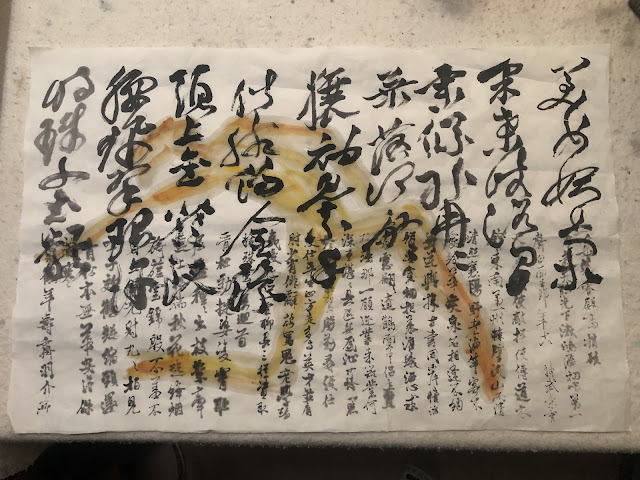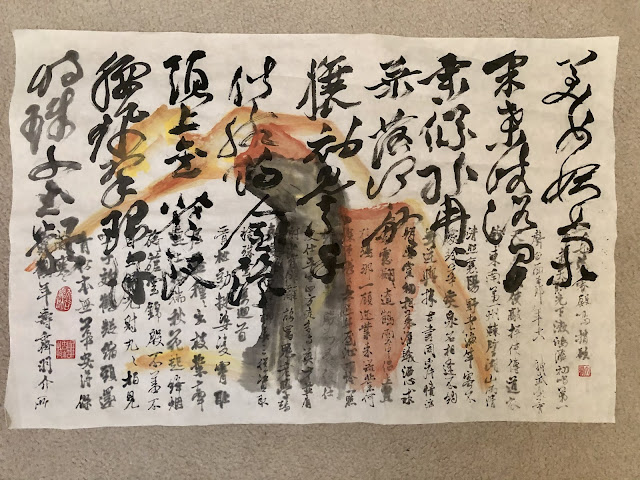I was not feeling particularly motivated to paint but I felt that I should not be keeping a distance from my brush and Xuan. I had not practiced any calligraphy for a long time so this was a most opportune time to brush up ( pun intended ). After all Chinese brush calligraphy is the foundation of Chinese brush painting. The quality of the brushstroke is a major determining factor in the intrinsic virtue of a Chinese brush painting.
I rolled out the Xuan on my desk and decided to practice the running style of Chinese calligraphy. As the name connotes, the running style is a calligraphy done in haste. The brushstrokes are more than cursive however. They are actually greatly reduced from the regular block fonts. To illustrate my point, try to imagine a cottage with a gable roof and two dormers and a detached garage. So these are the identifying features of this property. The cottage might have red shutters and green doors and triple pane windows but these are not features that one could pick out readily. Thus in the dim starlight, one can still pick out the gable roof and the two dormers and the detached garage. If one was asked to do a quick rendering of this cottage, one would just draw a gable roof roof with two dormers and a detached garage.
So are the brushstrokes in the running style of Chinese calligraphy. A lot of the details are missing, and only the most distinct "roots" of the font is written. Thus the running style fonts often require an educated guess to disambiguate, as they are not readily decipherable, especially when context is missing.
The fact that the calligraphy is done in haste, doesn't mean that I could write in haste, especially when I lack complete control of the brush. Imagine trying to do a triple Salchow double toe-double loop combo in ice skating. It looks graceful and fluid but it takes expert skills to determine speed, rotation and which side of the blade to exert force. Now imagine the brush as your skates and you are the skater. You can't rush it! The running style calligraphy is so deceptive.
My inadequacy became readily apparent after I filled the page, emulating a Ming calligrapher Zhu Yunming.
My hesitation and non-decision caused my brush to stay on the paper far too long resulting in a loss of definition of the brushstroke. Instead of seeing a serpent wriggling I saw dead earthworms striking poses on paper. The thin connecting brushstrokes should have happened naturally as a result of the brush lifting most of the way and then landing to form a new stroke. I however was forcing an abrupt lift and landing of the brush. I always compared this akwardness to people doing static poses to emulate runway models. What we see in a glamorous photo from fashion models is a single frame derived from results of thousands of continuous shutter clicking trying to capture the fluid translation of a flood of arrangements of the body and limbs. Thus trying to strike a static pose always seemed contrived and pretentious because it was not eased into. There was no hint of transition. So was my calligraphy.
I knew I was using the wrong kind of paper for my calligraphy. I read with tantalizing interest on the tidbits of stories of how these great masters of Chinese brush painting had their own custom papers and brushes made. I was only practicing so it really didn't matter, besides I am nowhere near that level of competence or excellence to demand custom paper. Suffice to know that different papers and different brushes do make a difference. This is not hearsay or folklore. My favorite paper to use was actually the one that is considered unrefined. It is made with unbleached bamboo fiber and has a rough and yellowish tint. I call it glorified toilet paper because it is super absorbent but doesn't bleed easily and is ideal for butt wiping. It is Maobian paper that I am referring to.
So I tried the same writing on the Maobian paper
Again it was painfully apparent that the ink bled like crazy and any reference to the tip and edge of the brush is all but gone. I wonder how much of that was me and if a master calligrapher could make this work all the same.
Just as I was ready to banish this piece of calligraphy exercise to my pile of etudes, as I call them, I was suddenly imbued with a notion. I caught a glimpse of my Pie Jesu piece in the corner of the floor. I attempted to visually dub the ballet dancer silhouettes with music score from Pie Jesu, perhaps I could add a dancer here to emulate Chinese calligraphy?
The limbs of a dancer seem perfect analogs for the individual strokes in a Chinese character, bending at the joints to give meaning or functionality to the dancer's pose, or to a Chinese character. The continued movements of the limbs and the body and the head of the dancer are no different from the twists and turns in the brushstrokes of the running style calligraphy. How far back does the dancer's head tilt and which shoulder is the gaze directed at is no different from the where the brush presses and lifts and where a vestigial dot ends up at.
Enough soliloquy, I picked up my brush and impulsively wrote my dancer, using whatever color was left in my dish. I was afraid that even the scant time spent on squeezing out the color tube could render my thoughts less lucid.
After my " id " phase was satisfied, my "ego" phase plunged in and began to analyze what I had done. I was made aware of the two different styles of calligraphy occupying two halves of the paper. Perhaps I could make my dancer along the same vein.
I decided to don my dancer in a two toned skirt to emulate the two font styles and I happened to have left over vermilion that I could rehydrate in the dish. Vermilion should go well with ink.
My doodling got out of hand.




